中南财经政法大学:《金融计量学》课程教学课件(双语讲稿)Chapter 10 Propensity Score Matching
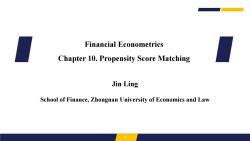
Financial Econometrics Chapter 10.Propensity Score Matching Jin Ling School of Finance,Zhongnan University of Economics and Law
Financial Econometrics Chapter 10. Propensity Score Matching Jin Ling School of Finance, Zhongnan University of Economics and Law 1
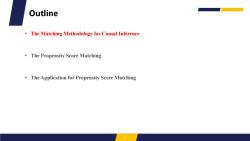
Outline The Matching Methodology for Causal Inference The Propensity Score Matching The Application for Propensity Score Matching 2
• The Matching Methodology for Causal Inference • The Propensity Score Matching • The Application for Propensity Score Matching 2 Outline

The Matching Methodology An review for causal inference: 。Treatment→Potential outcome. ·Doi→YoiD1i→Yi Yi=D;Y+(1-D:)Yo (Y:=Yi,如果D:=1 {Y:=Yu,如果D,=0 3
• An review for causal inference: • Treatment → Potential outcome. • 𝐷0𝑖 → 𝑌0𝑖 , 𝐷1𝑖 → 𝑌1𝑖 . 3 The Matching Methodology
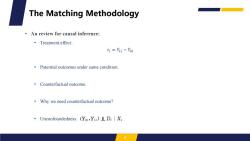
The Matching Methodology An review for causal inference: ·Treatment effect:. Ti=Yi-Yoi Potential outcomes under same condition. Counterfactual outcome. Why we need counterfactual outcome? Unconfoundedness:(Yoi,Y1)IL D:X;
• An review for causal inference: • Treatment effect:. 𝜏𝑖 = 𝑌1𝑖 − 𝑌0𝑖 • Potential outcomes under same condition. • Counterfactual outcome. • Why we need counterfactual outcome? • Unconfoundedness: . 4 The Matching Methodology

The Matching Methodology How to satisfy unconfoundedness: ·Control variable. Difference-in-difference model. Instrumental variable. 5
• How to satisfy unconfoundedness: • Control variable. • Difference-in-difference model. • Instrumental variable. 5 The Matching Methodology
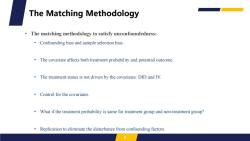
The Matching Methodology The matching methodology to satisfy unconfoundedness: Confounding bias and sample selection bias. The covariate affects both treatment probability and potential outcome. The treatment status is not driven by the covariates:DID and IV. Control for the covariates. What if the treatment probability is same for treatment group and non-treatment group? Replication to eliminate the disturbance from confounding factors. 6
• The matching methodology to satisfy unconfoundedness: • Confounding bias and sample selection bias . • The covariate affects both treatment probability and potential outcome. • The treatment status is not driven by the covariates: DID and IV. • Control for the covariates. • What if the treatment probability is same for treatment group and non-treatment group? • Replication to eliminate the disturbance from confounding factors. 6 The Matching Methodology
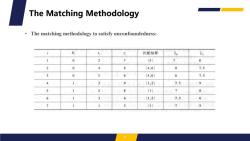
The Matching Methodology 。 The matching methodology to satisfy unconfoundedness: D 匹配结果 Yor 1 0 2 151 7 8 2 0 4 8 14,61 8 7.5 3 0 5 6 14.61 6 7.5 4 1 3 9 11,21 7.5 9 5 1 2 8 114 1 6 1 3 6 11.21 7.5 6 7 1 1 5 111 7 5 7
• The matching methodology to satisfy unconfoundedness: 7 The Matching Methodology
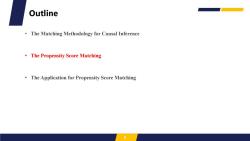
Outline The Matching Methodology for Causal Inference The Propensity Score Matching The Application for Propensity Score Matching 8
• The Matching Methodology for Causal Inference • The Propensity Score Matching • The Application for Propensity Score Matching 8 Outline
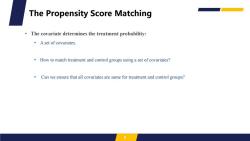
The Propensity Score Matching The covariate determines the treatment probability: 。A set of covariates. How to match treatment and control groups using a set of covariates? Can we ensure that all covariates are same for treatment and control groups? 9
• The covariate determines the treatment probability: • A set of covariates. • How to match treatment and control groups using a set of covariates? • Can we ensure that all covariates are same for treatment and control groups? 9 The Propensity Score Matching
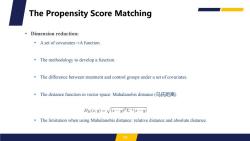
The Propensity Score Matching Dimension reduction: ·A set of covariates→A function. The methodology to develop a function. The difference between treatment and control groups under a set of covariates. ·The distance function in vector space:Mahalanobis distance(马氏距离) Dy(,y)=V(-y)TE-1(-y) The limitation when using Mahalanobis distance:relative distance and absolute distance. 10
• Dimension reduction: • A set of covariates→A function. • The methodology to develop a function. • The difference between treatment and control groups under a set of covariates. • The distance function in vector space: Mahalanobis distance (马氏距离) • The limitation when using Mahalanobis distance: relative distance and absolute distance. 10 The Propensity Score Matching
按次数下载不扣除下载券;
注册用户24小时内重复下载只扣除一次;
顺序:VIP每日次数-->可用次数-->下载券;
- 中南财经政法大学:《金融计量学》课程教学课件(双语讲稿)Chapter 01 Introduction to Financial Econometrics.pdf
- 中南财经政法大学:《中级计量经济学》课程教学课件(PPT讲稿)week 13 限值因变量模型和样本选择纠正.pptx
- 中南财经政法大学:《中级计量经济学》课程教学课件(PPT讲稿)week 11 高深的面板数据.pptx
- 中南财经政法大学:《中级计量经济学》课程教学课件(PPT讲稿)week 10 独立混合横截面数据.pptx
- 《中级计量经济学》课程教学资源(书籍文献)James H. Stock, Mark W. Watson - Introduction to Econometrics, Global Edition-Pearson Education Limited(2020).pdf
- 《中级计量经济学》课程教学资源(书籍文献)工具变量IV - IV paper-Acemoglu-ColonialOriginsComparative-2001.pdf
- 中南财经政法大学:《中级计量经济学》课程教学课件(PPT讲稿)week 9 工具变量估计与两阶段最小二乘法.pptx
- 中南财经政法大学:《中级计量经济学》课程教学课件(PPT讲稿)week 8 模型设定误差和数据问题.pptx
- 中南财经政法大学:《中级计量经济学》课程教学课件(PPT讲稿)week 6 异方差性(主讲:刘玲).pptx
- 中南财经政法大学:《中级计量经济学》课程教学课件(PPT讲稿)week 5 多元回归分析-深入专题.pptx
- 中南财经政法大学:《中级计量经济学》课程教学课件(PPT讲稿)week 4 多元回归分析-推断.pptx
- 中南财经政法大学:《中级计量经济学》课程教学课件(PPT讲稿)week 3 多元回归分析-估计.pptx
- 中南财经政法大学:《中级计量经济学》课程教学课件(PPT讲稿)week 2 简单回归模型.pptx
- 中南财经政法大学:《中级计量经济学》课程教学课件(PPT讲稿)week1 计量经济学的性质与经济数据.pptx
- 《平台经济学》课程教学课件(PPT讲稿)第八章 多边市场中的经验研究.pptx
- 《平台经济学》课程教学课件(PPT讲稿)第二章 双边市场中的垄断定价.pptx
- 《平台经济学》课程教学课件(PPT讲稿)第七章 双边市场中的政府规制.pptx
- 《平台经济学》课程教学课件(PPT讲稿)第六章 平台生态与平台治理.pptx
- 《平台经济学》课程教学课件(PPT讲稿)第五章 双边市场中的用户匹配.pptx
- 《平台经济学》课程教学课件(PPT讲稿)第一章 网络外部性、平台与双边市场.pptx
- 中南财经政法大学:《金融计量学》课程教学课件(双语讲稿)Chapter 11 Regression Discontinuity Design.pdf
- 中南财经政法大学:《金融计量学》课程教学课件(双语讲稿)Chapter 12 Application Policy Evaluation.pdf
- 中南财经政法大学:《金融计量学》课程教学课件(双语讲稿)Chapter 13 Application Corporate Finance.pdf
- 中南财经政法大学:《金融计量学》课程教学课件(双语讲稿)Chapter 14 Application Financial Market.pdf
- 中南财经政法大学:《金融计量学》课程教学课件(双语讲稿)Chapter 02 Statistical Foundations Overview of OLS.pdf
- 中南财经政法大学:《金融计量学》课程教学课件(双语讲稿)Chapter 03 Causal Inference framework 1.pdf
- 中南财经政法大学:《金融计量学》课程教学课件(双语讲稿)Chapter 04 Causal Inference framework 2.pdf
- 中南财经政法大学:《金融计量学》课程教学课件(双语讲稿)Chapter 05 Mediation Effect and Moderating Effect.pdf
- 中南财经政法大学:《金融计量学》课程教学课件(双语讲稿)Chapter 06 Control Variable and Fixed Effect.pdf
- 中南财经政法大学:《金融计量学》课程教学课件(双语讲稿)Chapter 07 Difference-in-difference Model 1.pdf
- 中南财经政法大学:《金融计量学》课程教学课件(双语讲稿)Chapter 08 Difference-in-difference Model 2.pdf
- 中南财经政法大学:《金融计量学》课程教学课件(双语讲稿)Chapter 09 Instrumental Variable Regression.pdf
- 《马克思主义政治经济学》课程教学课件(PPT讲稿)第一章 导论.ppt
- 《马克思主义政治经济学》课程教学课件(PPT讲稿)第七章 经济全球化与当代资本主义.ppt
- 《马克思主义政治经济学》课程教学课件(PPT讲稿)第三章 剩余价值理论.ppt
- 《马克思主义政治经济学》课程教学课件(PPT讲稿)第二章 马克思与劳动价值论.ppt
- 《马克思主义政治经济学》课程教学课件(PPT讲稿)第五章 资本社会化与资本主义所有制.ppt
- 《马克思主义政治经济学》课程教学课件(PPT讲稿)第八章 资本主义的未来.ppt
- 《马克思主义政治经济学》课程教学课件(PPT讲稿)第六讲 资本主义市场经济体制与资本主义经济的发展.ppt
- 《马克思主义政治经济学》课程教学课件(PPT讲稿)第四章 本积累和资本主义分配制度.ppt
